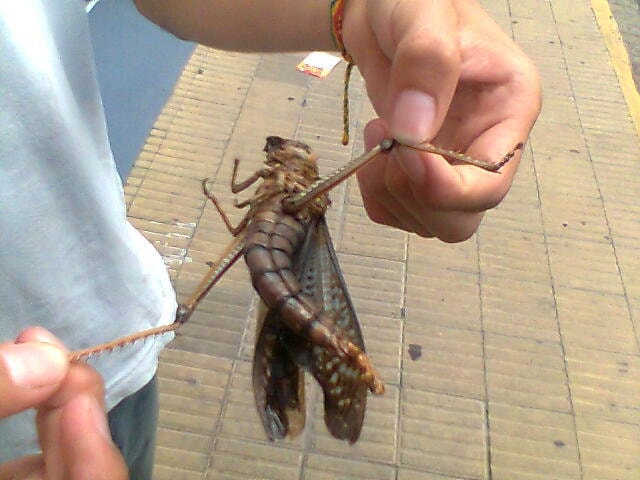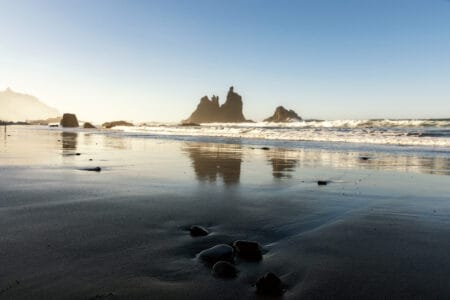Picture this: you’re strolling through Tenerife’s charming northern village of Tacoronte, breathing in that familiar Atlantic breeze, when suddenly the sky darkens with something that shouldn’t be there. Millions of locusts, carried across the ocean by the very winds that normally bring us that fine African dust we call calima. It sounds biblical, doesn’t it? Yet this extraordinary phenomenon has been visiting our beloved Canary Islands for centuries.
I’ll be honest, when I first heard about locusts reaching our shores from Africa, I thought someone was having me on. But the reality is far more fascinating than fiction, and it’s a story that connects our islands to ancient climate patterns, modern weather systems, and the incredible journeys these tiny creatures make across the sea.
The Unwelcome Passengers of the Calima
We’re all familiar with the calima that rolls in from the Sahara, turning our skies orange and covering our cars in a fine layer of dust. What many of us don’t realise is that these dust storms sometimes bring more than just suspended particles, they carry swarms of African locusts that have been spotted across various parts of Tenerife and other islands.
It’s quite remarkable when you think about it. These insects manage to survive a journey of hundreds of kilometres across open ocean. They don’t plan it, of course. They’re simply caught up in the same powerful weather systems that bring us the calima, riding the winds until they find themselves deposited on our volcanic shores.
The most recent documented cases occurred in 2023, when residents across Tenerife started reporting unusual swarms. But this isn’t a new phenomenon at all. Historical records show that locusts have been reaching the Canary Islands, particularly Fuerteventura and Lanzarote, since at least November 2004, when immature adults and swarms from Northwest Africa made the crossing.
A Pattern Written in Stone

Here’s where it gets really interesting. Scientists have discovered that locust invasions aren’t just a modern curiosity, they’re part of a pattern that stretches back through geological time. Research has revealed that palaeosols on the islands contain innumerable relict egg pods of temperate-region locusts, showing that these plagues have been occurring since the Late Pliocene period.
Think about that for a moment. Long before humans ever set foot on these islands, locusts were already making this incredible journey. It suggests that the atmospheric conditions that allow these crossings have been remarkably consistent over geological time scales.
What’s particularly fascinating is how these ancient arrivals are preserved in our landscape. Between the basalt lavas that form our islands are marine deposits and wind-blown sands that tell the story of past climate changes. And nestled within these layers are the fossilised remains of locust invasions from tens of thousands of years ago.
The Science Behind the Swarm
You might wonder how exactly these creatures survive such an epic journey. The answer lies in the remarkable nature of desert locusts and the specific weather patterns of our region. A single swarm can travel up to 90 miles a day and contain 80 million locusts, and when they’re caught in the right wind patterns, they can be carried far beyond their intended destination.
The process typically works like this: intense heat and specific humidity conditions in Northwest Africa trigger swarming behaviour. The locusts take to the air, and if the timing aligns with the atmospheric rivers that carry the calima, they become unwitting passengers on a one-way flight to the Canaries.
Most don’t survive the journey, of course. The ones that do arrive are often exhausted, disoriented, and struggling to adapt to our different climate and vegetation. That’s why when locust invasions do occur, they typically subside relatively quickly, with western winds often pushing the remaining swarms back toward the sea.
More Than Just a Natural Curiosity
While these locust arrivals might seem like nothing more than an interesting natural phenomenon, they actually serve as important indicators of broader environmental changes. The frequency and intensity of these events can tell us about shifting weather patterns, atmospheric circulation changes, and even climate trends across the North Atlantic region.
For those of us living here, there’s also a practical element to consider. Although the locusts that reach us are usually too exhausted to cause significant agricultural damage, they can still impact local vegetation and create temporary nuisances in affected areas.
I’ve spoken to farmers on Fuerteventura and Lanzarote who remember the 2004 invasion, and while it wasn’t catastrophic, it was certainly memorable. Gardens stripped bare overnight, the constant sound of wings, and the surreal experience of walking through clouds of insects; it’s not something you forget easily.
Frequently Asked Questions
Are locust invasions dangerous to humans? Not directly. The locusts that reach the Canaries are typically exhausted from their journey and more focused on finding food and water than anything else. They don’t bite humans, though they can be a nuisance and may damage vegetation.
How often do these invasions happen? There’s no regular pattern, but documented cases suggest they occur roughly every decade or two, depending on specific weather conditions in both Africa and the Atlantic circulation patterns.
Can we predict when they’ll arrive? To some extent, yes. Meteorologists can track the atmospheric conditions that would allow such crossings, and there are early warning systems in place, particularly for the eastern islands that are typically affected first.
Do the locusts establish permanent populations here? No. The climate and ecosystem of the Canaries aren’t suitable for these African species to establish breeding populations. They typically die off within weeks or months of arrival.
Looking Forward
As our climate continues to change, it’s likely we’ll see shifts in these patterns too. Some scientists suggest that changing atmospheric circulation could make such crossings either more or less frequent, but it’s still too early to say definitively.
What’s certain is that these extraordinary journeys will continue to fascinate us, serving as a reminder of just how connected our islands are to the vast African continent beyond the horizon. The next time you’re caught in a calima, take a moment to consider that you might be sharing the experience with some very tired, very lost locusts who’ve just completed one of nature’s most improbable journeys.
There’s something oddly comforting about knowing that this phenomenon has been part of our islands’ story for millennia. It connects us not just to the African mainland, but to the deep history of our volcanic home, written in layers of stone and preserved in the most unexpected places.
Next time the sky turns that familiar orange and the dust settles on your terrace, you’ll know there’s far more to the story than meets the eye. Sometimes the most extraordinary events are hiding in plain sight, carried on the very winds we’ve learned to live with.






